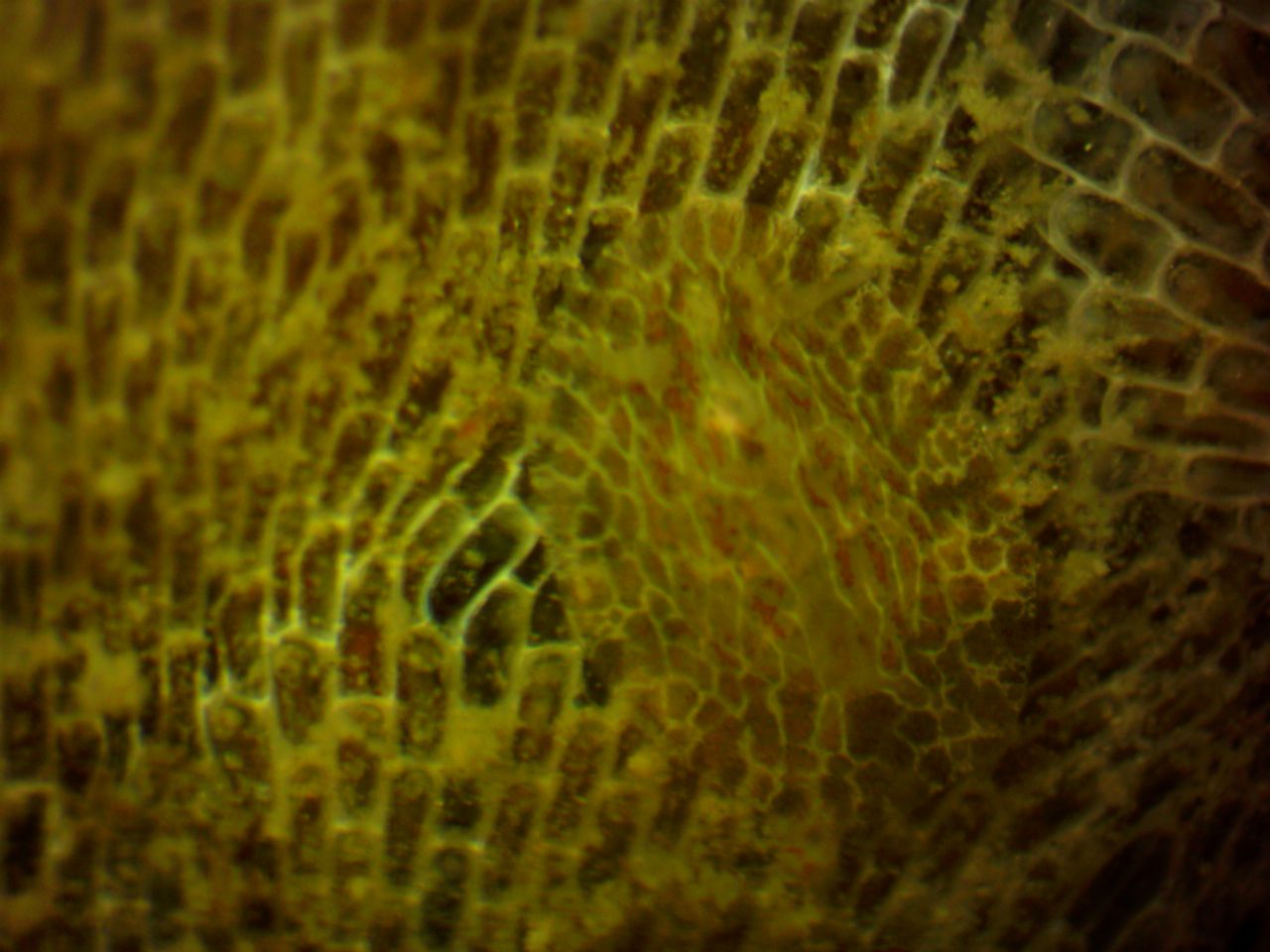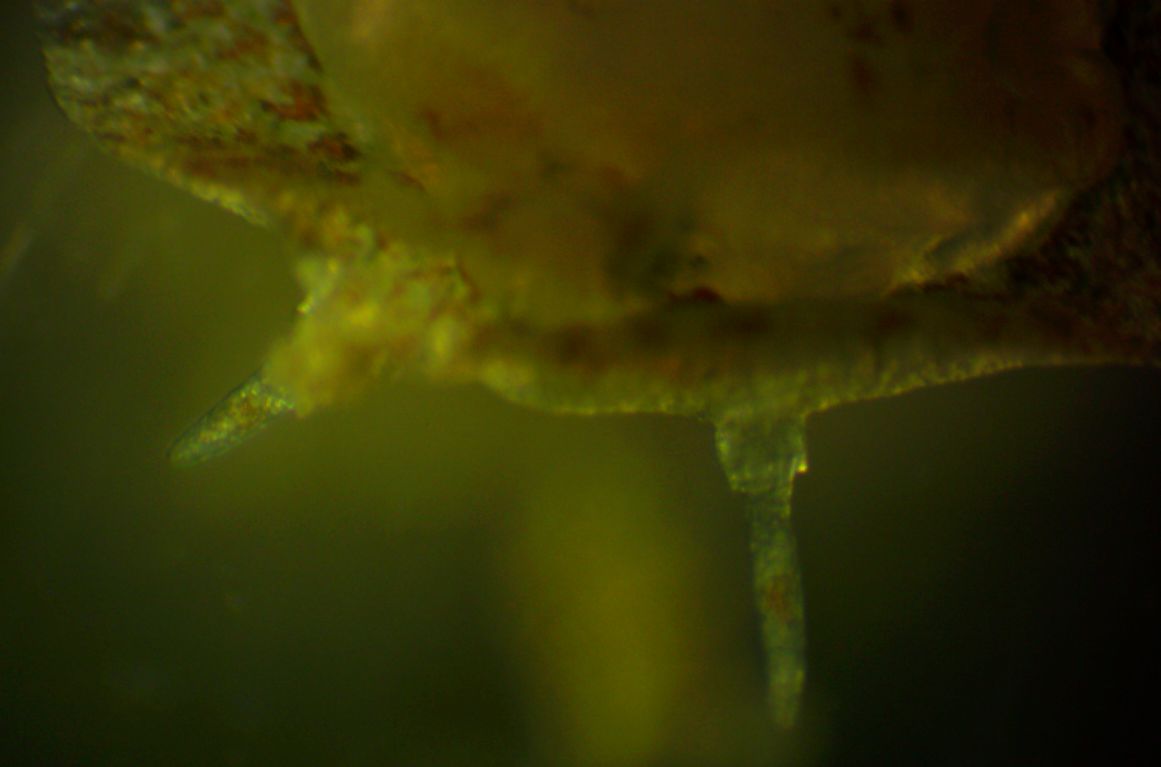Corambe steinbergae (Lance, 1962)Common name(s): Cryptic nudibranch, Steinberg's dorid, Joan Steinberg's corambe, Membranipora bryozoan nudibranch |
|
| Synonyms: Corambella steinbergi, Corambella bolini, Corambe mosaica, Doridella steinbergae, Suhinia steinbergi, Paracorambe steinbergi |  |
|
Class Gastropoda
Family Corambidae
|
|
| Corambe steinbergae, about 2 mm long, on a colony of Membranipora membranacea growing on a kelp frond. | |
| (Photo by: Dave Cowles, July 2017) | |
Description: This tiny nudibranch lives and feeds on the bryozoan Membranipora membranacea, and blends in to the surface patterns extremely well. Instead of having a ring of gills around the posterodorsal anus, the anus is on the posterior midline of the body in the groove between the foot and the dorsum and it has 1-2 gills on each side of the anus (photo). The dorsum is smooth without dorsal tubercles, ridges, nor cerata, but does have simple, tapered rhinophores (photo) and a pattern of gray and yellow-brown spots and white lines that look very much like the pattern of zooids on the surface of M. membranacea. There is no notch on the posterior border of the dorsum. Length to 1.7 cm but usually 5 mm or less. Many may be only 1 mm long.
How to Distinguish from Similar Species:Corambe pacifica has a notch on the posterior dorsum and has 6-14 gills.
Geographical Range: Central Alaska to Baja California, Mexico
Depth Range: Intertidal and subtidal
Habitat: Lives and feeds on the bryozoan Membranipora membranacea, which lives on various species of kelp.
Biology/Natural
History: In Washington
it lays tiny masses of eggs in individual capsules in July and August,
attached to the kelp. The egg masses of C.
steinbergae are curved but never exceed one complete turn
(360 degrees),
while those of C.
pacifica,
which may be found in similar places, usually have more than one and
may
have 2-3 turns (Anderson, 1971). The larvae hatch as a trochophore,
change
to a veliger and swim for about a month, and settle on kelp
blades. Membranipora
membranacea which are being attacked by this
nudibranch frequently
develop large spines on some of the zooids
within 36 hours, which decreases the rate of feeding of the nudibranchs.
The nudibranch
may be found on M.
membranacea year-round but is most abundant in
summer when kelp
and bryozoan
growth is most robust.At Friday Harbor in the summer, this nudibranch
can reach a density of 240 individuals per plant for Laminaria
saccharina kelp less than 1 m long (Seed, 1976).
| Return to: | |||
| Main Page | Alphabetic Index | Systematic Index | Glossary |
References:
Dichotomous Keys:Kozloff, 1987, 1996 (as Doridella steinbergae)
General References:
Behrens, 1991
Harbo, 2011
Lamb and Hanby, 2005 (As D.
steinbergi)
Morris et al., 1980 (as D.
steinbergae)
Scientific Articles:
Anderson, Genevieve B., 1971. A contribution to the biology
of Doridella
steinbergae
and Corambe
pacifica. M.A.
thesis, California State University, Hayward. 63 pp.
Lance, James Robert, 1962. A new Stiliger and a new Corambella (Mollusca: Opisthobranchia) from the northeastern Pacific. Veliger 5:1 pp 33-38, plate 6, and figures 6-10.
Seed, R., 1976. Observations on the ecology of Membranipora (bryozoa) and a major predator Doridella steinbergae (nudibranchiata) along the fronds of Laminaria saccharina at Friday Harbor, Washington. Journal of Experimental Marine Biology and Ecology 24:1 pp 1-17
Turner, Teresa, 1978. Adaptive significance of foot forms and types of locomotion in Opisthobranchs. M.A. Thesis, California State University, Hayward. 66 pp.
Web sites:
General Notes and Observations: Locations, abundances, unusual behaviors:

In this view from the underside, the head can be seen on the left and
the two clusters of gills, which flank the posterior anus in the cleft
between the dorsum
and the foot, can be seen projecting on the right. Photo by Dave
Cowles,
July 2017

In this view of the head from below, the rhinophores
can be seen projecting from the dorsum
as the nudibranch
looks down toward the camera. Photo by Dave Cowles, July 2017
To see a short movie which shows the animal and bryozoan
together and how well the animal is camouflaged on the bryozoan
surface, click here.
Movie by Dave Cowles, July 2017
Authors and Editors
of Page:
Dave Cowles (2017): Created original page
CSS coding for page developed by Jonathan Cowles
Salish Sea Invertebrates web site provided courtesy of Walla
Walla University